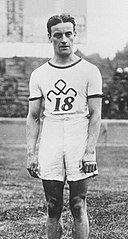William Applegarth
| |||||||||||||
 | |||||||||||||
| Data i miejsce urodzenia | 11 maja 1890 Guisborough | ||||||||||||
| Data i miejsce śmierci | 5 grudnia 1958 Schenectady | ||||||||||||
| Wzrost | 170 cm | ||||||||||||
| Dorobek medalowy | |||||||||||||
|---|---|---|---|---|---|---|---|---|---|---|---|---|---|
| |||||||||||||
William Reuben Applegarth (ur. 11 maja 1890 w Guisborough w North Yorkshire, zm. 5 grudnia 1958 w Schenectady w stanie Nowy Jork[1]) – brytyjski lekkoatleta sprinter, mistrz olimpijski ze Sztokholmu z 1912.
Rozpoczął swoją karierę lekkoatletyczną w 1910, kiedy zajął 3. miejsce w mistrzostwach Wielkiej Brytanii (AAA) w biegu na 100 jardów[2]. W 1912 zwyciężył w tych mistrzostwach w biegu na 220 jardów[3] i był drugi na 100 jardów[2].
Na igrzyskach olimpijskich w 1912 w Sztokholmie zdobył brązowy medal w biegu na 200 metrów za Amerykanami Ralphem Craigiem i Donem Lippincottem. Startował także w biegu na 100 metrów, odpadając w półfinale. Największy sukces odniósł w sztafecie 4 × 100 metrów, w której wraz z kolegami (byli to David Jacobs, Henry Macintosh i Victor d’Arcy) najpierw awansował do finału po dyskwalifikacji sztafety Stanów Zjednoczonych za przekazanie pałeczki poza strefą zmian, a później w finale zdobył złoty medal[1].
Krótko po igrzyskach Applegarth wyrównał należący do Lippincotta rekord świata w biegu na 100 metrów wynikiem 10,6 s[4]. W 1913 i 1914 zdobył mistrzostwo Wielkiej Brytanii (AAA) zarówno na 100 jardów[2], jak i na 220 jardów[3]. Podczas tych zawodów w 1914 ustanowił rekord świata w biegach na 220 jardów i na 200 m wynikiem 21,2 s[5].
W listopadzie 1914 podpisał zawodowy kontrakt lekkoatletyczny. W 1922 wyemigrował do Stanów Zjednoczonych, gdzie pracował jako trener lekkoatletyki i piłki nożnej. Grał tam również w piłkę nożną w miejscowej lidze. Później prawował jako spawacz w General Electric. Zmarł w wieku 68 lat w roku, w którym został pobity jego brytyjski rekord na 100 jardów (9,8 s)[1].
Przypisy
- ↑ a b c Willie Applegarth, olympedia.org [dostęp 2021-05-11] (ang.).
- ↑ a b c AAA and National Championships Medallists – 100 yards and 100 metres, nuts.org.uk [dostęp 2021-05-11] (ang.).
- ↑ a b AAA and National Championships Medallists – 220 yards and 200 metres, nuts.org.uk [dostęp 2021-05-11] (ang.).
- ↑ Progression of IAAF World Records. 2015 Edition, IAAF, 2015, s. 23 [dostęp 2021-05-11] (ang.).
- ↑ Progression of IAAF World Records. 2015 Edition, IAAF, 2015, s. 42 [dostęp 2021-05-11] (ang.).
| ||||
Media użyte na tej stronie
Pictograms of Olympic sports – . This is an unofficial sample picture. Images of official Olympic pictograms for 1948 Summer Olympics and all Summer Olympics since 1964 can be found in corresponding Official Reports.
The flag of Navassa Island is simply the United States flag. It does not have a "local" flag or "unofficial" flag; it is an uninhabited island. The version with a profile view was based on Flags of the World and as a fictional design has no status warranting a place on any Wiki. It was made up by a random person with no connection to the island, it has never flown on the island, and it has never received any sort of recognition or validation by any authority. The person quoted on that page has no authority to bestow a flag, "unofficial" or otherwise, on the island.
Flag of the unified Team of Germany for the Olympic Games, 1960–1968.
Flag of Jamaica. “The sunshine, the land is green, and the people are strong and bold” is the symbolism of the colours of the flag. GOLD represents the natural wealth and beauty of sunlight; GREEN represents hope and agricultural resources; BLACK represents the strength and creativity of the people. The original symbolism, however, was "Hardships there are, but the land is green, and the sun shineth", where BLACK represented the hardships being faced.
Olympic Games, Stockholm, Sweden, Men's 200 Metres, Great Britain's W,R, Applegarth who won the bronze medal







